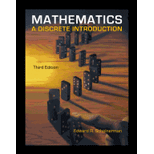
Mathematics: A Discrete Introduction
3rd Edition
ISBN: 9780840049421
Author: Edward A. Scheinerman
Publisher: Cengage Learning
expand_more
expand_more
format_list_bulleted
Question
Chapter 2, Problem 13ST
i.
To determine
To find if the given statement is true
ii.
To determine
To determine if the given statement is true
iii.
To determine
To find if the given statement is true
iv.
To determine
To determine if the given statement is true
v.
To determine
To find if the given statement is true
vi.
To determine
To find if the given statement is true
vii.
To determine
To find if the given statement is true
viii.
To determine
To find if the given statement is true
Expert Solution & Answer
Want to see the full answer?
Check out a sample textbook solution
Students have asked these similar questions
Find all solutions of the polynomial congruence
x²+4x+1 = 0 (mod 143).
(The solutions of the congruence x² + 4x+1=0 (mod 11) are x = 3,4 (mod 11) and the
solutions of the congruence x² +4x+1 = 0 (mod 13) are x = 2,7 (mod 13).)
https://www.hawkeslearning.com/Statistics/dbs2/datasets.html
Determine whether each function is an injection and determine whether each is a surjection.The notation Z_(n) refers to the set {0,1,2,...,n-1}. For example, Z_(4)={0,1,2,3}. f: Z_(6) -> Z_(6) defined by f(x)=x^(2)+4(mod6). g: Z_(5) -> Z_(5) defined by g(x)=x^(2)-11(mod5). h: Z*Z -> Z defined by h(x,y)=x+2y. j: R-{3} -> R defined by j(x)=(4x)/(x-3).
Chapter 2 Solutions
Mathematics: A Discrete Introduction
Ch. 2.8 - Write out all the possible two-letter words one...Ch. 2.8 - Airports have names, but they also have...Ch. 2.8 - Prob. 8.3ECh. 2.8 - Prob. 8.4ECh. 2.8 - Prob. 8.5ECh. 2.8 - Prob. 8.6ECh. 2.8 - Prob. 8.7ECh. 2.8 - Prob. 8.8ECh. 2.8 - Prob. 8.9ECh. 2.8 - Prob. 8.10E
Ch. 2.8 - Prob. 8.11ECh. 2.8 - Prob. 8.12ECh. 2.8 - Prob. 8.13ECh. 2.8 - Prob. 8.14ECh. 2.8 - Prob. 8.15ECh. 2.8 - Prob. 8.16ECh. 2.8 - Prob. 8.17ECh. 2.8 - Prob. 8.18ECh. 2.8 - Prob. 8.19ECh. 2.9 - Prob. 9.1ECh. 2.9 - Prob. 9.2ECh. 2.9 - Prob. 9.3ECh. 2.9 - Prob. 9.4ECh. 2.9 - Prob. 9.5ECh. 2.9 - Prob. 9.6ECh. 2.9 - Prob. 9.7ECh. 2.9 - Prob. 9.8ECh. 2.9 - Prob. 9.9ECh. 2.9 - Prob. 9.10ECh. 2.9 - Prob. 9.11ECh. 2.9 - Prob. 9.12ECh. 2.9 - Prob. 9.13ECh. 2.9 - Prob. 9.14ECh. 2.9 - Prob. 9.15ECh. 2.9 - Prob. 9.16ECh. 2.9 - Prob. 9.17ECh. 2.9 - Prob. 9.18ECh. 2.10 - Prob. 10.1ECh. 2.10 - Prob. 10.2ECh. 2.10 - Prob. 10.3ECh. 2.10 - Prob. 10.4ECh. 2.10 - Prob. 10.5ECh. 2.10 - Prob. 10.6ECh. 2.10 - Prob. 10.7ECh. 2.10 - Prob. 10.8ECh. 2.10 - Prob. 10.9ECh. 2.10 - Let A=x:4x and let B=x:2x. Prove that AB.Ch. 2.10 - Prob. 10.11ECh. 2.10 - Prob. 10.12ECh. 2.10 - Prob. 10.13ECh. 2.10 - Prob. 10.14ECh. 2.10 - Prob. 10.15ECh. 2.11 - Write the following sentences using the quantifier...Ch. 2.11 - Prob. 11.2ECh. 2.11 - Prob. 11.3ECh. 2.11 - Prob. 11.4ECh. 2.11 - Prob. 11.5ECh. 2.11 - Prob. 11.6ECh. 2.11 - Prob. 11.7ECh. 2.11 - Prob. 11.8ECh. 2.12 - Prob. 12.1ECh. 2.12 - Prob. 12.2ECh. 2.12 - Prob. 12.3ECh. 2.12 - Prob. 12.4ECh. 2.12 - Prob. 12.5ECh. 2.12 - Prob. 12.6ECh. 2.12 - Prob. 12.7ECh. 2.12 - Prob. 12.8ECh. 2.12 - Prob. 12.9ECh. 2.12 - Prob. 12.10ECh. 2.12 - Prob. 12.11ECh. 2.12 - Prob. 12.12ECh. 2.12 - Prob. 12.13ECh. 2.12 - Prob. 12.14ECh. 2.12 - Prob. 12.15ECh. 2.12 - Prob. 12.16ECh. 2.12 - Prob. 12.17ECh. 2.12 - Prob. 12.18ECh. 2.12 - Prob. 12.19ECh. 2.12 - Prob. 12.20ECh. 2.12 - Prob. 12.21ECh. 2.12 - Prob. 12.22ECh. 2.12 - Prob. 12.23ECh. 2.12 - Prob. 12.24ECh. 2.12 - Prob. 12.25ECh. 2.12 - Prob. 12.26ECh. 2.12 - Prob. 12.27ECh. 2.12 - Prob. 12.28ECh. 2.12 - Prob. 12.29ECh. 2.12 - Prob. 12.30ECh. 2.13 - Prob. 13.1ECh. 2.13 - Prob. 13.2ECh. 2.13 - Prob. 13.3ECh. 2.13 - Prob. 13.4ECh. 2.13 - Prob. 13.5ECh. 2.13 - Prob. 13.6ECh. 2.13 - Prob. 13.7ECh. 2 - Prob. 1STCh. 2 - Prob. 2STCh. 2 - Prob. 3STCh. 2 - Prob. 4STCh. 2 - Prob. 5STCh. 2 - Prob. 6STCh. 2 - Prob. 7STCh. 2 - Prob. 8STCh. 2 - Prob. 9STCh. 2 - Prob. 10STCh. 2 - Prob. 11STCh. 2 - Prob. 12STCh. 2 - Prob. 13STCh. 2 - Prob. 14STCh. 2 - Prob. 15STCh. 2 - Prob. 16STCh. 2 - Prob. 17STCh. 2 - Prob. 18STCh. 2 - Prob. 19STCh. 2 - Prob. 20ST
Knowledge Booster
Learn more about
Need a deep-dive on the concept behind this application? Look no further. Learn more about this topic, subject and related others by exploring similar questions and additional content below.Similar questions
- Determine whether each function is an injection and determine whether each is a surjection.arrow_forwardLet A = {a, b, c, d}, B = {a,b,c}, and C = {s, t, u,v}. Draw an arrow diagram of a function for each of the following descriptions. If no such function exists, briefly explain why. (a) A function f : AC whose range is the set C. (b) A function g: BC whose range is the set C. (c) A function g: BC that is injective. (d) A function j : A → C that is not bijective.arrow_forwardLet f:R->R be defined by f(x)=x^(3)+5.(a) Determine if f is injective. why?(b) Determine if f is surjective. why?(c) Based upon (a) and (b), is f bijective? why?arrow_forward
- 25-30. Normal and tangential components For the vector field F and curve C, complete the following: a. Determine the points (if any) along the curve C at which the vector field F is tangent to C. b. Determine the points (if any) along the curve C at which the vector field F is normal to C. c. Sketch C and a few representative vectors of F on C. 25. F = (2½³, 0); c = {(x, y); y − x² = 1} 26. F = x (23 - 212) ; C = {(x, y); y = x² = 1}) , 2 27. F(x, y); C = {(x, y): x² + y² = 4} 28. F = (y, x); C = {(x, y): x² + y² = 1} 29. F = (x, y); C = 30. F = (y, x); C = {(x, y): x = 1} {(x, y): x² + y² = 1}arrow_forward٣/١ B msl kd 180 Ka, Sin (1) I sin () sin(30) Sin (30) اذا ميريد شرح الكتب بس 0 بالفراغ 3) Cos (30) 0.866 4) Rotating 5) Synchronous speed, 120 x 50 G 5005 1000 s = 1000-950 Copper bosses 5kW Rotor input 5 0.05 : loo kw 6) 1 /0001 ined sove in peaper I need a detailed solution on paper please وه اذا ميريد شرح الكتب فقط ١٥٠ DC 7) rotor a ' (y+xlny + xe*)dx + (xsiny + xlnx + dy = 0. Q1// Find the solution of: ( 357arrow_forward۳/۱ R₂ = X2 2) slots per pole per phase 3/31 B. 180 msl Kas Sin (I) 1sin() sin(30) Sin (30) اذا ميريد شرح الكتب بس 0 بالفراغ 3) Cos (30): 0.866 4) Rotating 5) Synchronous speeds 120×50 looo G 1000-950 1000 Copper losses 5kw Rotor input 5 loo kw 0.05 6) 1 اذا ميريد شرح الكتب فقط look 7) rotor DC ined sove in peaper I need a detailed solution on paper please 0 64 Find the general solution of the following equations: QI//y(4)-16y= 0. Find the general solution of the following equations: Q2ll yll-4y/ +13y=esinx.arrow_forward
- R₂ = X2 2) slots per pole per phase = 3/31 B-180 60 msl kd Kas Sin () 2 I sin (6) sin(30) Sin (30) اذا مريد شرح الكتب بس 0 بالفراغ 3 Cos (30) 0.866 4) Rotating ined sove in peaper 5) Synchronous speed s 120×50 6 s = 1000-950 1000 Copper losses 5kw Rotor input 5 0.05 6) 1 loo kw اذا ميريد شرح الكتب فقط Look 7) rotov DC I need a detailed solution on paper please 0 64 Solve the following equations: 0 Q1// Find the solution of: ( y • with y(0) = 1. dx x²+y²arrow_forwardR₂ = X2 2) slots per pole per phase = 3/3 1 B-180-60 msl Ka Sin (1) Isin () sin(30) Sin (30) اذا ميريد شرح الكتب بس 0 بالفراغ 3) Cos (30) 0.866 4) Rotating 5) Synchronous speed, 120 x 50 s = 1000-950 1000 Copper losses 5kw Rotor input 5 6) 1 0.05 G 50105 loo kw اذا ميريد شرح الكتب فقط look 7) rotov DC ined sove in peaper I need a detailed solution on paper please 064 2- A hot ball (D=15 cm ) is cooled by forced air T.-30°C, the rate of heat transfer from the ball is 460.86 W. Take for the air -0.025 Wim °C and Nu=144.89, find the ball surface temperature a) 300 °C 16 b) 327 °C c) 376 °C d) None か = 750 01arrow_forwardAnswer questions 8.3.3 and 8.3.4 respectively 8.3.4 .WP An article in Medicine and Science in Sports and Exercise [“Electrostimulation Training Effects on the Physical Performance of Ice Hockey Players” (2005, Vol. 37, pp. 455–460)] considered the use of electromyostimulation (EMS) as a method to train healthy skeletal muscle. EMS sessions consisted of 30 contractions (4-second duration, 85 Hz) and were carried out three times per week for 3 weeks on 17 ice hockey players. The 10-meter skating performance test showed a standard deviation of 0.09 seconds. Construct a 95% confidence interval of the standard deviation of the skating performance test.arrow_forward
arrow_back_ios
SEE MORE QUESTIONS
arrow_forward_ios
Recommended textbooks for you
 Elementary Geometry For College Students, 7eGeometryISBN:9781337614085Author:Alexander, Daniel C.; Koeberlein, Geralyn M.Publisher:Cengage,
Elementary Geometry For College Students, 7eGeometryISBN:9781337614085Author:Alexander, Daniel C.; Koeberlein, Geralyn M.Publisher:Cengage, Elements Of Modern AlgebraAlgebraISBN:9781285463230Author:Gilbert, Linda, JimmiePublisher:Cengage Learning,
Elements Of Modern AlgebraAlgebraISBN:9781285463230Author:Gilbert, Linda, JimmiePublisher:Cengage Learning, Algebra: Structure And Method, Book 1AlgebraISBN:9780395977224Author:Richard G. Brown, Mary P. Dolciani, Robert H. Sorgenfrey, William L. ColePublisher:McDougal Littell
Algebra: Structure And Method, Book 1AlgebraISBN:9780395977224Author:Richard G. Brown, Mary P. Dolciani, Robert H. Sorgenfrey, William L. ColePublisher:McDougal Littell Elementary Linear Algebra (MindTap Course List)AlgebraISBN:9781305658004Author:Ron LarsonPublisher:Cengage LearningAlgebra & Trigonometry with Analytic GeometryAlgebraISBN:9781133382119Author:SwokowskiPublisher:Cengage
Elementary Linear Algebra (MindTap Course List)AlgebraISBN:9781305658004Author:Ron LarsonPublisher:Cengage LearningAlgebra & Trigonometry with Analytic GeometryAlgebraISBN:9781133382119Author:SwokowskiPublisher:Cengage Elementary Geometry for College StudentsGeometryISBN:9781285195698Author:Daniel C. Alexander, Geralyn M. KoeberleinPublisher:Cengage Learning
Elementary Geometry for College StudentsGeometryISBN:9781285195698Author:Daniel C. Alexander, Geralyn M. KoeberleinPublisher:Cengage Learning

Elementary Geometry For College Students, 7e
Geometry
ISBN:9781337614085
Author:Alexander, Daniel C.; Koeberlein, Geralyn M.
Publisher:Cengage,

Elements Of Modern Algebra
Algebra
ISBN:9781285463230
Author:Gilbert, Linda, Jimmie
Publisher:Cengage Learning,

Algebra: Structure And Method, Book 1
Algebra
ISBN:9780395977224
Author:Richard G. Brown, Mary P. Dolciani, Robert H. Sorgenfrey, William L. Cole
Publisher:McDougal Littell

Elementary Linear Algebra (MindTap Course List)
Algebra
ISBN:9781305658004
Author:Ron Larson
Publisher:Cengage Learning

Algebra & Trigonometry with Analytic Geometry
Algebra
ISBN:9781133382119
Author:Swokowski
Publisher:Cengage

Elementary Geometry for College Students
Geometry
ISBN:9781285195698
Author:Daniel C. Alexander, Geralyn M. Koeberlein
Publisher:Cengage Learning
Grade 12 and UG/ Introduction to logical statements and truth tables; Author: Dr Trefor Bazett;https://www.youtube.com/watch?v=q2eyZZK-OIk;License: Standard YouTube License, CC-BY